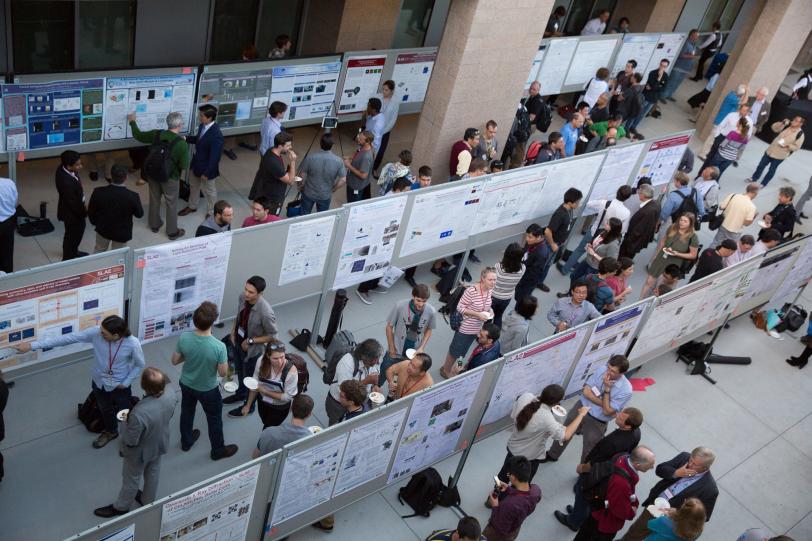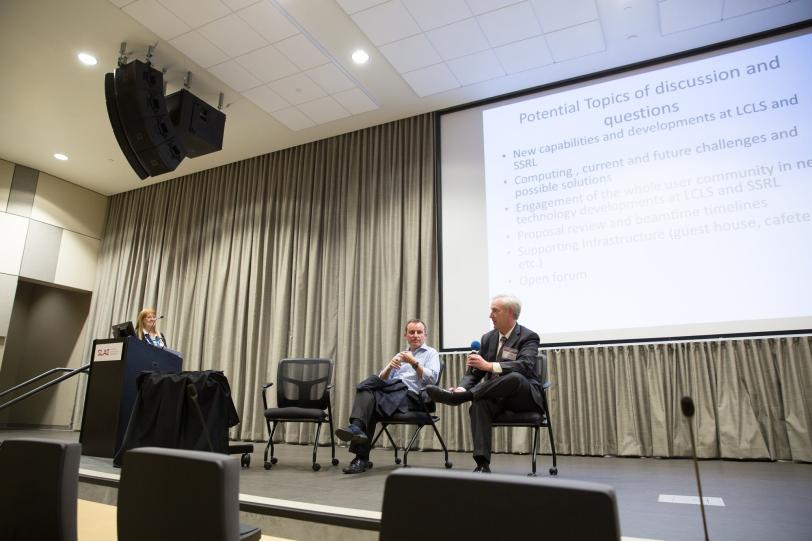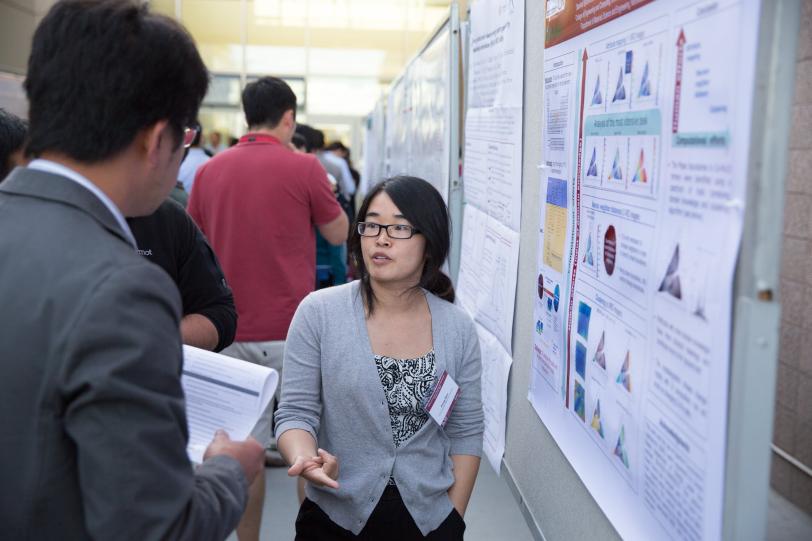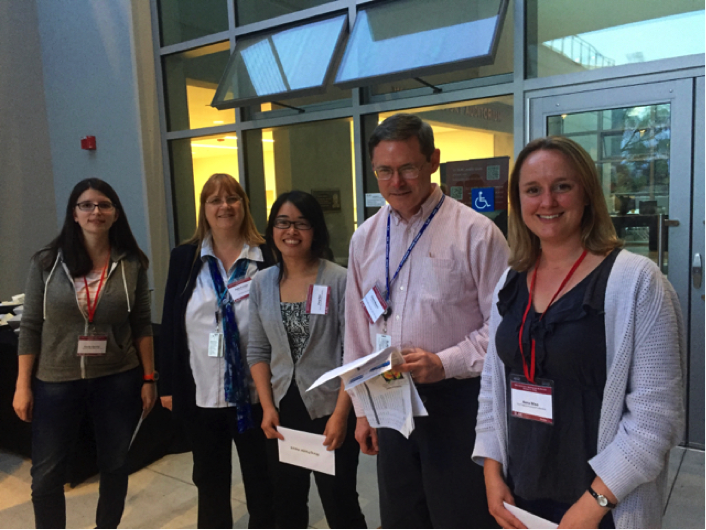Scientists Gather for Annual SLAC Users’ Conference
New Poster Competition, LCLS-II Update Among Meeting Highlights
More than 400 participants came to the Department of Energy's SLAC National Accelerator Laboratory for the 2016 LCLS/SSRL Annual Users' Meeting and Workshops, held Oct. 5-8.
Sessions covered developments in the field of X-ray science, specific advances in technology at SLAC, and hands-on training for researchers.
As DOE Office of Science User Facilities, the Linac Coherent Light Source (LCLS) and the Stanford Synchrotron Radiation Lightsource (SSRL) are open to researchers from around the world. These light sources use extremely bright X-rays to explore matter at very small scales.
“Our job is to make sure that you can do state-of-the-art X-ray experiments, and understand and interpret the results,” Kelly Gaffney, director of SSRL, said during his presentation. “A key component for our strategic planning and keeping up to date are the workshops at the Users’ Meeting.”
Mike Dunne, LCLS director, said increasing researcher access to the X-ray free-electron laser was a major goal for the past year. To do this, the facility has offered standard experimental configurations to enable rapid turnaround between successive research groups and worked to maximize the parallel running of experiments, known as "multiplexing". LCLS saw a 50 percent increase in user experiments in 2016.
The coming years will bring two extended shutdown periods in preparation for LCLS-II, the next generation of SLAC’s X-ray laser.
“This is a very intense time in terms of decision making and putting new capabilities in place. We’d like you to give us detailed feedback on the ways we can shape the facility to work for you,” Dunne told participants.
Meeting Highlights
The presentations and workshops focused on successful collaborations, new capabilities and future technology at SSRL and LCLS.
LCLS Deputy for Science Robert Schoenlein presented scientific opportunities and the current timeline for the LCLS-II upgrade, as well as a look ahead to the proposed ‘high energy’ extension known as LCLS-II-HE. First light for LCLS-II is expected in 2020, when early experiments will start with the new laser, he explained. The laser’s brightness and high repetition rate will create opportunities for unique research.
“With up to 10 billion snapshots a day, the technology provides new opportunities for capturing rare, transient events,” Schoenlein said.
In data analysis workshops, LCLS and SSRL scientists provided tutorials and demonstrated how machine learning could be used to classify detector images.
SSRL and the Joint Center for Artificial Photosynthesis (JCAP) organized a combined workshop about studying catalysts in action with the latest X-ray spectroscopy methods. During his presentation, Ian Sharp, a principal investigator at JCAP, discussed his experiences at SSRL and other user facilities while characterizing materials designed to capture solar energy to convert carbon dioxide to fuel.
“I think it says something that of the more than 300 papers JCAP has published, over 90 have co-authors at user facilities," said Sharp. “That speaks to the collaborative efforts needed for today’s large-scale science."
After the end of the four-day meeting, BioXFEL hosted a young investigators session with a career discussion panel and a tour of LCLS.
At a satellite event held just after the annual user's conference, the Stanford PULSE Institute also celebrated their 10-year anniversary at a symposium. The research talks covered extreme states of matter, magnetization dynamics and other areas of ultrafast science studied in PULSE experiments, concluding with a group dinner.
Awards
During the conference, SSRL honored three researchers with awards:
- Makoto Hashimoto, staff scientist, received the Farrel W. Lytle Award for his research on high-temperature superconductors and his role in developing an experimental station at SSRL that allows researchers to study superconductivity and other states of matter.
- Yijin Liu, staff scientist, won the William E. and Diane M. Spicer Young Investigator Award for his X-ray microscopy work that spans batteries, catalysis for petroleum refining, carbon sequestration, material under extreme conditions, and big data mining.
- Stanford graduate student Trevor Petach accepted the Melvin P. Klein Scientific Development Award. The award acknowledges Petach’s outstanding efforts as a new investigator in condensed matter physics and electrochemistry at SSRL.
For the first time, the annual meeting also included the Joe Wong Poster Awards, a competition created with support from long-time SSRL user Joe Wong. Wong retired in 2006 from Lawrence Livermore National Laboratory with seven patents, 12 awards and more than 200 publications. He also helped build the first X-ray beamline at Brookhaven National Laboratory.
The awards are given to “the most exciting, novel and compelling science” presented during the poster session. The contest is open to all LCLS and SSRL users, based on research results from either facility. One award is designated for students, and researchers at any stage of their career can compete for additional awards.
Three outstanding young women scientists received the inaugural poster awards:
- Camila Bacellar, graduate student at the University of California, Berkeley/Lawrence Berkeley National Laboratory, “Imaging Anisotropic Nanoplasma Dynamics in Superfluid Helium Droplets”
- Fang Ren, Stanford University/SSRL Materials Science Division, “Identify Phases in Materials - Human or Robot?”
- Anna Wise, Stanford University/SSRL Materials Science Division, “High Resolution Chemical Mapping of Energy-related Materials: Development of Soft X-ray Ptychograpy at SSRL”
For questions or comments, contact the SLAC Office of Communications at communications@slac.stanford.edu.
SLAC is a multi-program laboratory exploring frontier questions in photon science, astrophysics, particle physics and accelerator research. Located in Menlo Park, Calif., SLAC is operated by Stanford University for the U.S. Department of Energy's Office of Science.
SLAC National Accelerator Laboratory is supported by the Office of Science of the U.S. Department of Energy. The Office of Science is the single largest supporter of basic research in the physical sciences in the United States, and is working to address some of the most pressing challenges of our time. For more information, please visit science.energy.gov.










